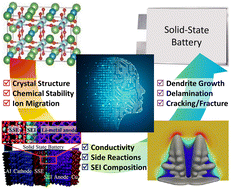Computational approach inspired advancements of solid-state electrolytes for lithium secondary batteries: from first-principles to machine learning
Abstract
The increasing demand for high-security, high-performance, and low-cost energy storage systems (EESs) driven by the adoption of renewable energy is gradually surpassing the capabilities of commercial lithium-ion batteries (LIBs). Solid-state electrolytes (SSEs), including inorganics, polymers, and composites, have emerged as promising candidates for next-generation all-solid-state batteries (ASSBs). ASSBs offer higher theoretical energy densities, improved safety, and extended cyclic stability, making them increasingly popular in academia and industry. However, the commercialization of ASSBs still faces significant challenges, such as unsatisfactory interfacial resistance and rapid dendrite growth. To overcome these problems, a thorough understanding of the complex chemical–electrochemical–mechanical interactions of SSE materials is essential. Recently, computational methods have played a vital role in revealing the fundamental mechanisms associated with SSEs and accelerating their development, ranging from atomistic first-principles calculations, molecular dynamic simulations, multiphysics modeling, to machine learning approaches. These methods enable the prediction of intrinsic properties and interfacial stability, investigation of material degradation, and exploration of topological design, among other factors. In this comprehensive review, we provide an overview of different numerical methods used in SSE research. We discuss the current state of knowledge in numerical auxiliary approaches, with a particular focus on machine learning-enabled methods, for the understanding of multiphysics-couplings of SSEs at various spatial and time scales. Additionally, we highlight insights and prospects for SSE advancements. This review serves as a valuable resource for researchers and industry professionals working with energy storage systems and computational modeling and offers perspectives on the future directions of SSE development.



 Please wait while we load your content...
Please wait while we load your content...